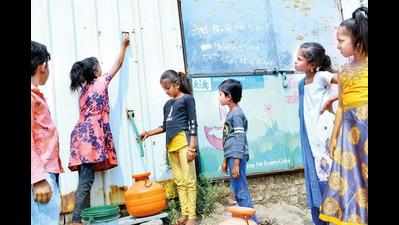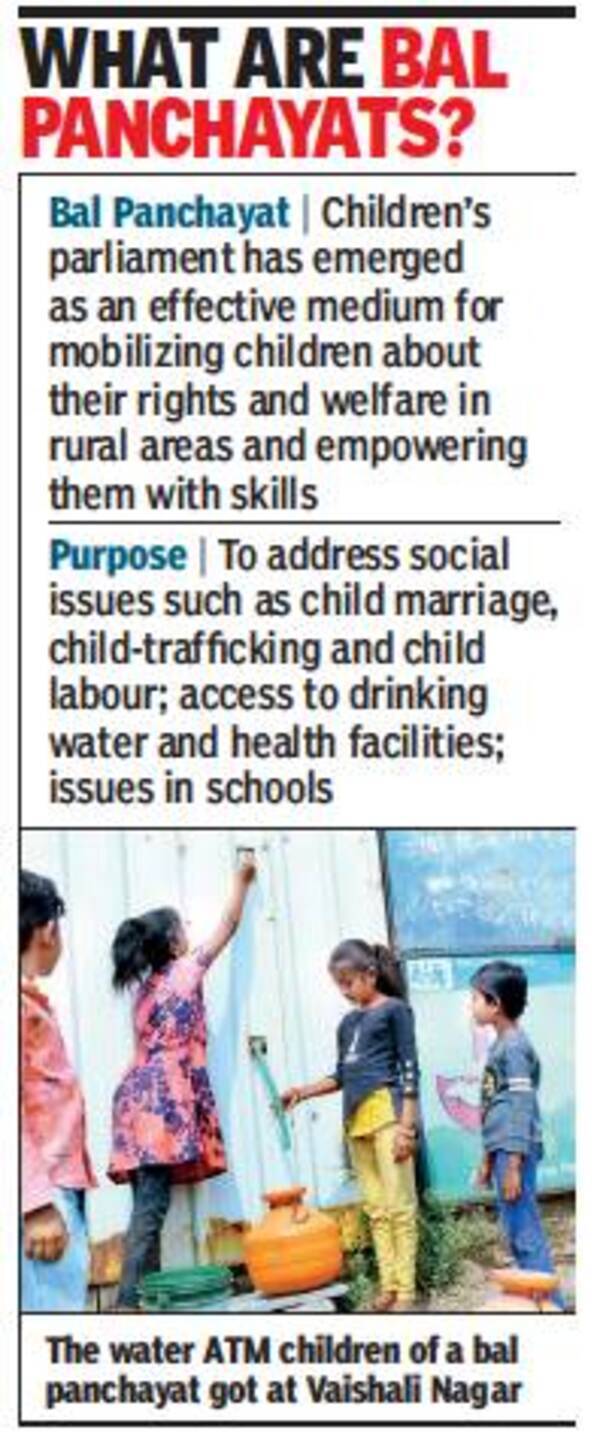- News
- City News
- mumbai News
- Maharashtra: Kids lift Latur village out of water scarcity
Trending
This story is from March 30, 2021
Maharashtra: Kids lift Latur village out of water scarcity
They say it takes a village to raise a child. In a curious case, it took children to lift Vaishali Nagar, a village in Latur — that has been the face of Marathwada’s acute water scarcity — out of a crisis.

The water ATM children of a bal panchayat got a Vaishali Nagar
They say it takes a village to raise a child. In a curious case, it took children to lift Vaishali Nagar, a village in Latur — that has been the face of Marathwada’s acute water scarcity — out of a crisis.
Water shortage is a familiar story in Maharashtra. But 2018 was different for around 1,200 people who had no drinking water, groundwater levels had plummeted and hand pumps ran dry three months after the monsoon.
When scorching summer heat would drive up thirst and water tankers came to the rescue, fights would break out between women queuing up for water. With lives and dreams revolving around water, access to it determined choices families could make. And children often bore the brunt.

Like Asha and Priya’s parents, most in Vaishali Nagar are daily wagers. As a desperate measure, fetching and hauling pitchers of water, sometimes over several miles, fell disproportionately on children, especially girls.
But what Asha or Priya did not imagine was that bringing up their water woes — that snatched away time they had to study or go to school, or even play — at a meeting of ‘bal panchayat’ or children’s parliament, would change what had been a constant concern for years.
Modelled on a gram panchayat and informally recognised by the district administration, many villages in the state have witnessed this unique revolution of a powerful children’s collective. They usually comprise 25 children aged 11-18 and are guided by local NGOs. The small, dusty village of Sategaon in Parbhani district was the first in Maharashtra to develop this model of child governance in 2000. Today, the state has over 200 bal panchayats.
Initially, they focused on bringing drop-outs back to school by convincing parents, raising questions about condition of schools and volunteering to clean them up. Today, they fight social evils like child marriage and child labour; work for birth registration, tree plantation and campaign against children’s addiction to tobacco. Members meet at least twice a month to learn about child rights, skills and discuss issues in their village, to bring them to the notice of the gram sabha, and get them solved.
So, when complaining about grievances to teachers or parents was not an option, Asha and Priya, along with other members, decided to fight for themselves and the 200 children of their village, and place their demand for potable water facilities before their gram panchayat.
Predictably, adults did not take them seriously when few kids turned up at their door. “They gave children a fleeting assurance of organising a water tanker but nothing happened. Around 30 children turned up again in few weeks, this time with a letter when they realised the children meant business,” recounted Saroj Pawar, a mentor from SOS Children’s Villages of India, a non-profit child care organization that helped form the Vaishali Nagar bal panchayat.
“The sarpanch had to call for a meeting with the children and other village elders,” said Pawar. Turned out the village was sitting on a water ATM scheme which was never initiated as people were not willing to pay.
Breaking ice with villagers unwilling to spend money on water was the next challenge for the children, who went about convincing neighbours. “We visited homes till they were clear about what this would mean to us children, and improve their lives,” recalls Asha.
After six months, the panchayat got a borewell and a water purifier plant installed at Vaishali Nagar in a symbolic gesture on August 15, the day of India’s Independence. “We helped clear the area of shrubs and rocks when the borewell was being drilled, drew rangolis for the opening and got to inaugurate the water ATM,” gushed Priya.
It has been two years since. The kiosk runs, with people inserting Rs5 coins for 20 litres of water. “Pleading by children has an emotional appeal that creates greater ethical pressure on adults. Hearing children speak, the community starts questioning their own lack of concern and paying heed to issues,” explained Pawar.
While safe and affordable water at the “magical” press of a button has brought a smile to residents of this once water-stressed patch, for the children it has been a fount of hope. “We don’t have to miss school any more, no more fights between neighbours and water-borne diseases have come down,” said Asha and Priya. Today, they harbour dreams of being a police officer and a doctor.
But before that they have other missions to accomplish. “We have water but hygiene is still a problem. Next on our bal panchayat agenda is getting the gram sabha to ensure a regular garbage collection truck.”
Water shortage is a familiar story in Maharashtra. But 2018 was different for around 1,200 people who had no drinking water, groundwater levels had plummeted and hand pumps ran dry three months after the monsoon.
When scorching summer heat would drive up thirst and water tankers came to the rescue, fights would break out between women queuing up for water. With lives and dreams revolving around water, access to it determined choices families could make. And children often bore the brunt.

With the sun blazing at 38 degrees, 11-year-old Asha — instead of attending school — would walk three days a week to a borewell a km from home, standing for hours on a baking pavement and trudging home with heavy water pitchers balanced with practised perfection on her waist and head. For 12-year-old Priya, collecting water was about saving her frail and enervated mother from collapsing in the heat and her father from shutting down their grocery store for a day.
Like Asha and Priya’s parents, most in Vaishali Nagar are daily wagers. As a desperate measure, fetching and hauling pitchers of water, sometimes over several miles, fell disproportionately on children, especially girls.
But what Asha or Priya did not imagine was that bringing up their water woes — that snatched away time they had to study or go to school, or even play — at a meeting of ‘bal panchayat’ or children’s parliament, would change what had been a constant concern for years.
Modelled on a gram panchayat and informally recognised by the district administration, many villages in the state have witnessed this unique revolution of a powerful children’s collective. They usually comprise 25 children aged 11-18 and are guided by local NGOs. The small, dusty village of Sategaon in Parbhani district was the first in Maharashtra to develop this model of child governance in 2000. Today, the state has over 200 bal panchayats.
Initially, they focused on bringing drop-outs back to school by convincing parents, raising questions about condition of schools and volunteering to clean them up. Today, they fight social evils like child marriage and child labour; work for birth registration, tree plantation and campaign against children’s addiction to tobacco. Members meet at least twice a month to learn about child rights, skills and discuss issues in their village, to bring them to the notice of the gram sabha, and get them solved.
So, when complaining about grievances to teachers or parents was not an option, Asha and Priya, along with other members, decided to fight for themselves and the 200 children of their village, and place their demand for potable water facilities before their gram panchayat.
Predictably, adults did not take them seriously when few kids turned up at their door. “They gave children a fleeting assurance of organising a water tanker but nothing happened. Around 30 children turned up again in few weeks, this time with a letter when they realised the children meant business,” recounted Saroj Pawar, a mentor from SOS Children’s Villages of India, a non-profit child care organization that helped form the Vaishali Nagar bal panchayat.
“The sarpanch had to call for a meeting with the children and other village elders,” said Pawar. Turned out the village was sitting on a water ATM scheme which was never initiated as people were not willing to pay.
Breaking ice with villagers unwilling to spend money on water was the next challenge for the children, who went about convincing neighbours. “We visited homes till they were clear about what this would mean to us children, and improve their lives,” recalls Asha.
After six months, the panchayat got a borewell and a water purifier plant installed at Vaishali Nagar in a symbolic gesture on August 15, the day of India’s Independence. “We helped clear the area of shrubs and rocks when the borewell was being drilled, drew rangolis for the opening and got to inaugurate the water ATM,” gushed Priya.
It has been two years since. The kiosk runs, with people inserting Rs5 coins for 20 litres of water. “Pleading by children has an emotional appeal that creates greater ethical pressure on adults. Hearing children speak, the community starts questioning their own lack of concern and paying heed to issues,” explained Pawar.
While safe and affordable water at the “magical” press of a button has brought a smile to residents of this once water-stressed patch, for the children it has been a fount of hope. “We don’t have to miss school any more, no more fights between neighbours and water-borne diseases have come down,” said Asha and Priya. Today, they harbour dreams of being a police officer and a doctor.
But before that they have other missions to accomplish. “We have water but hygiene is still a problem. Next on our bal panchayat agenda is getting the gram sabha to ensure a regular garbage collection truck.”
End of Article
FOLLOW US ON SOCIAL MEDIA










